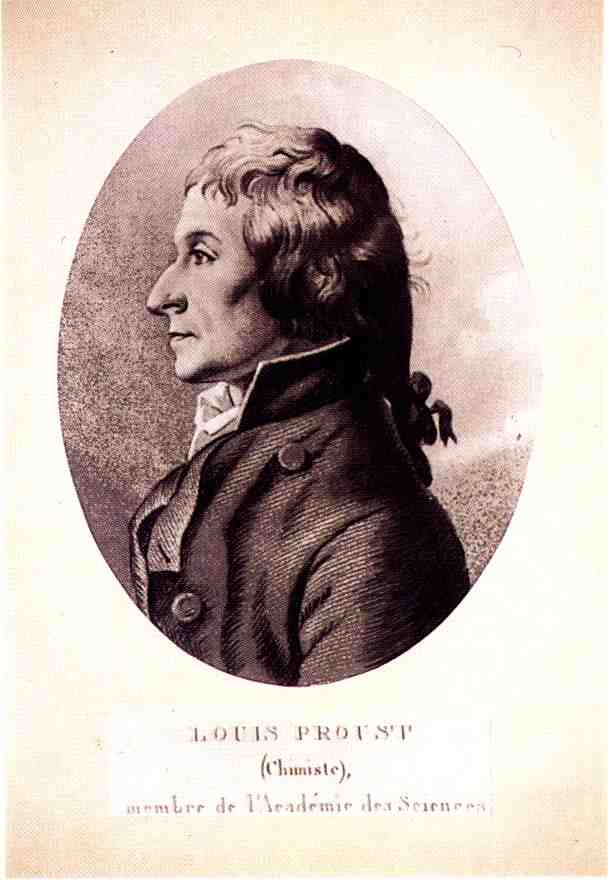He became known by his research work on the steadiness of composition of chemical compounds
(aka Law of Definite Proportion).
Personal Life
September 26, 1754 – July 5, 1826 (Angers, France)
Proust's Father was a pharmaceutic. He Studied chemistry in his father’s shop and later came to Paris where he gained the appointment of apothecary in chief to the Salpetriere. He too, was chief- pharmaceutic in Salpetrière by the time he became interested in ascension balloons. He also taught chemistry with Pilâtre de Rozier, a famous astronaut. He taught at the Chemistry School in Segovia and at the University of Salamanca, in Spain.
Joseph Proust was appointed to the Royal Laboratory in Madrid under the influence of Carlos IV. After Napoleon Bonaparte invaded Spain, he returned to France.
Achievements in Chemistry
Proust disproved chemist Berthollet with a new law, the Law Of Definite Proportions (a.ka. Proust's law). He performed series of researches which characterize different types of sugars, present in vegetable products.
Law of Definite Proportions and Elements
Also known as the ‘Proust’s Law’
This law states that a chemical compound always contains exactly the same proportion of elements by mass.
 An equivalent statement is the law of constant composition, which states that all samples of a given chemical compound have the same elemental composition. Along with the law of multiple proportions by John Dalton, which states that when chemical elements combine they do so in a ratio of small whole numbers, the law of definite proportions forms the basis of stoichiometry.
An equivalent statement is the law of constant composition, which states that all samples of a given chemical compound have the same elemental composition. Along with the law of multiple proportions by John Dalton, which states that when chemical elements combine they do so in a ratio of small whole numbers, the law of definite proportions forms the basis of stoichiometry.
History of the Law of Definite Proportions and Elements
Blog By:
Victoria So
 An equivalent statement is the law of constant composition, which states that all samples of a given chemical compound have the same elemental composition. Along with the law of multiple proportions by John Dalton, which states that when chemical elements combine they do so in a ratio of small whole numbers, the law of definite proportions forms the basis of stoichiometry.
An equivalent statement is the law of constant composition, which states that all samples of a given chemical compound have the same elemental composition. Along with the law of multiple proportions by John Dalton, which states that when chemical elements combine they do so in a ratio of small whole numbers, the law of definite proportions forms the basis of stoichiometry.History of the Law of Definite Proportions and Elements
At the end of the 18th century, when the concept of a chemical compound had not yet been fully developed, the law was novel.
In fact, when first proposed, it was a controversial statement and was opposed by other chemists, most notably Proust's fellow Frenchman Claude Louis Berthollet, who argued that the elements could combine in any proportion. The very existence of this debate underscores that at the time, the distinction between pure chemical compounds and mixtures had not yet been fully developed.
The law of definite proportions contributed to, and was placed on a firm theoretical basis by, the atomic theory that John Dalton promoted beginning in 1803, which explained matter as consisting of discrete atoms, that there was one type of atom for each element, and that the compounds were made of combinations of different types of atoms in fixed proportions.
More on the Law of Definite Proportions
Proust studied copper carbonate, the two tin oxides,and the two iron sulfides to prove this law. He did this by making artificial copper carbonate and comparing it to natural copper carbonate. With this he showed that each had the same proportion of weights between the three elements involved (Cu, C, O). Between the two types of the other compounds, Proust showed that no intermediate indeterminate compounds exist between them. Proust published this paper in 1794, but the law was not accepted until 1811, when the Swedish chemist Jöns Jacob Berzelius gave him credit for it.
There are, however, exceptions to the Law of Definite Proportions. An entire class of substances does not follow this rule. The compounds are called non-stoichiometric compounds, or Berthollides, after Berthollet. The ratio of the elements present in the compound can fluctuate within certain limits, such as in the example of Ferrous oxide. The ideal formula is FeO, but due to crystallographic vacancies it is reduced to about Fe0.95O
Blog By:
II-DD Chem
Belle BautistaVictoria So
Michelle Wong


No comments:
Post a Comment